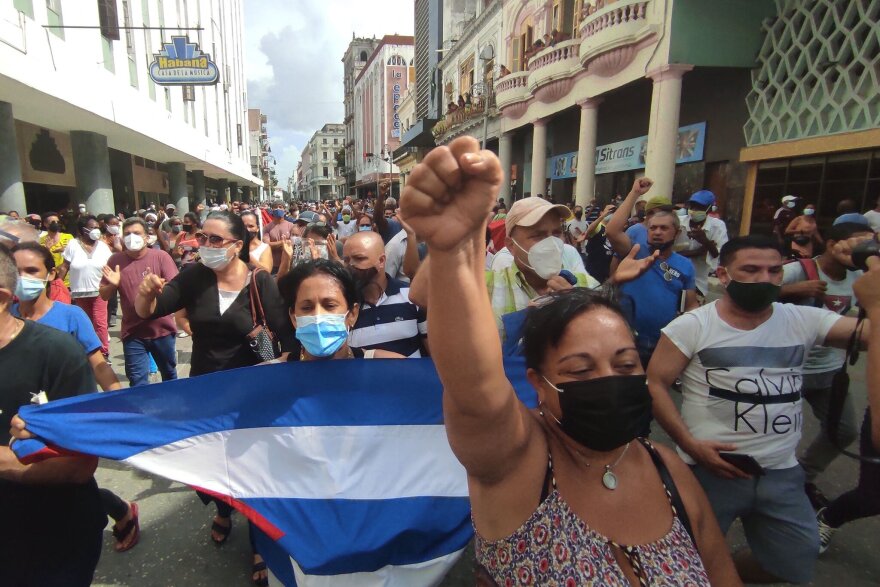The world had not seen anything from Cuba like the anti-government street protests that erupted across the communist island Sunday — not, in fact, since protests against the Batista dictatorship that helped bring the communist regime to power in 1959.
And the world saw it thanks to the social media skills Cubans have gained since the regime recently let them access the internet.
WLRN is committed to providing the trusted news and local reporting you rely on. Please keep WLRN strong with your support today. Donate now. Thank you.
On Sunday that featured countless videos streamed out of Cuba from all across the island, showing tens of thousands of Cubans protesting their government’s repression and mismanagement while shouting “No tenemos miedo!” — We’re not afraid! — and riding the momentum of hashtags like #SOSCuba. Or even angrier, unprecedented scenes of Cubans overturning police cars and shouting insults at cops.
Inside Cuba, that content burned across social media platforms like fuses, igniting powder kegs of frustration in more than a dozen cities and towns over issues like chronic shortages of food, medicine and electricity. Outside Cuba, especially in Miami, the unrest raised hopes of regime change.
READ MORE: Cuban Socialism Meets Social Media. This Summer It's a New Revolution
But late Sunday it looked as if the government had shut off the world’s view of the protests by shutting off the internet. Monday morning, few abroad knew if the protests were continuing.
Until many heard of a young Cuban exile in Panama named Alain Rodríguez, who calls himself a Cuban influencer and goes by the name Alain Paparazzi Cubano on his YouTube show.
Cubans here in South Florida noticed Paparazzi sharing protest videos people sent him from Cuba on Monday. But watching his online show, they couldn’t figure out how.
“He described it as a tunnel, some sort of secret connection," said Reuben Rojas, a Cuban-American in Hialeah who runs the nonprofit Other Oceans — building cultural bridges between Cuba and Miami.
The “tunnel” Rojas is referring to is a way people often get around government internet censorship by using virtual private networks, or VPNs.
“I’m pretty informed about Cuba, and I had never heard of Alain Paparazzi," said Rojas. "But this kid is doing what no one else is doing, at the same time the Cuban government is literally shutting the island's communications down.”
Rojas says what Paparazzi did most was confirm the regime’s brutal response to the protesters.
“There was a lot of video rolling in of people getting completely beat up, shot," Rojas said.
The internet released the genie from the bottle in Cuba. Even if the regime controls these protests this time, they're just going to come back, bigger and bigger, in ways it least expects it.Guennady Rodriguez
Despite those disturbing images, Rojas says the fact that Cubans somehow got video and other content to Paparazzi that day means this: They know how to use social media as well, if not better, than the regime knows how to control it.
“Cuba has survived 62 years without much communication," Rojas noted. "So couple its highly skilled word-of-mouth, neighbor-to-neighbor tradition with internet technology, and now suddenly an Alain Paparazzi is creating tunnels providing information like this to us on a VPN.”
TELEGRAM IT
Other Cubans here say they’re not convinced Paparazzi created a VPN tunnel — and advise viewers and mainstream media to scrutinize content coming through outlets like Paparazzi's program. WLRN reached out to Paparazzi in Panama but he did not respond.
"If some of these 'secret connections' were really doable, I think the U.S. government would have exploited them a long time ago," said Guennady Rodriguez, a Cuban immigrant in Miami who runs the website 23yFlagler – meaning the virtual corner of 23rd Street in Havana and Flagler Street here in Miami.
Still, Rodriguez (no relation to Alain) says Paparazzi's broadcasts show how ingenuously determined Cubans, especially young Cubans, are to "find any way to get this information out."
On Monday and Tuesday, lists of the names of Cubans missing or arrested in the protests were making their way off the island despite the regime's internet shutdown — as were videos like one of Cuban police storming the house of a protester in Cárdenas, Cuba that have gone viral. The protester's family told El Nuevo Herald the police also shot him.

Rodriguez suggests outlets, like Paparazzi's, are likely receiving content like that primarily from Cubans who’ve gained access to what government or hotel WiFi the regime needs to keep open on the island. They then use the VPN "tunnels" to conceal their identities and transmissions from the government. And he agrees the regime is losing the communications battle.
“The internet, it released the genie from the bottle in Cuba, you know?" Rodriguez said.
"So even if the regime controls these protests this time — and they will — it’s just going to come back, bigger and bigger, in ways they least expect it, as has already been happening.”
Cubans have in fact been using social media for the past two years to spark anti-government protests in ways the regime least expected it. It happened two years ago this summer; it happened again last November and is happening now — each time, as Rodriguez notes, bigger and bolder.
And more sophisticated. Rodriguez points out the most popular messaging app among Cubans now is Telegram, which is more securely encrypted than platforms like WhatsApp.
That allows them more freedom to achieve what Cuban-American playwright Carmen Pelaez of Miami says is the social media objective of these protests.
“The myth of the Cuban Revolution is being dismantled one Instagram post at a time,” she said.
And those Cubans say they're dismantling it sin miedo — without fear.





